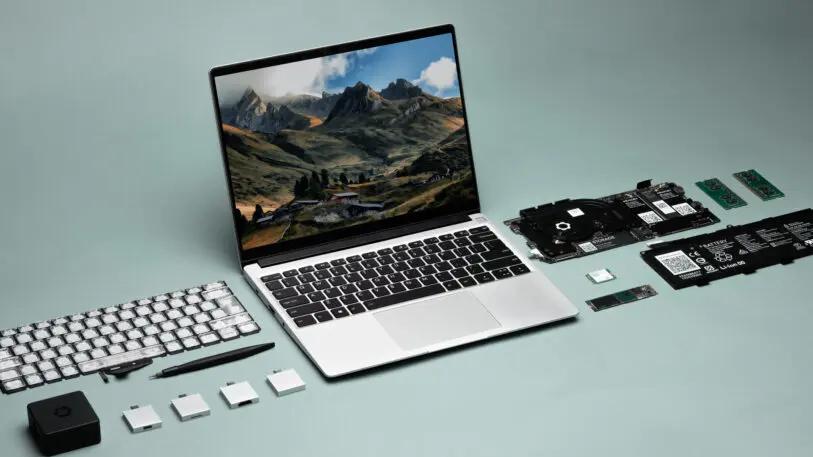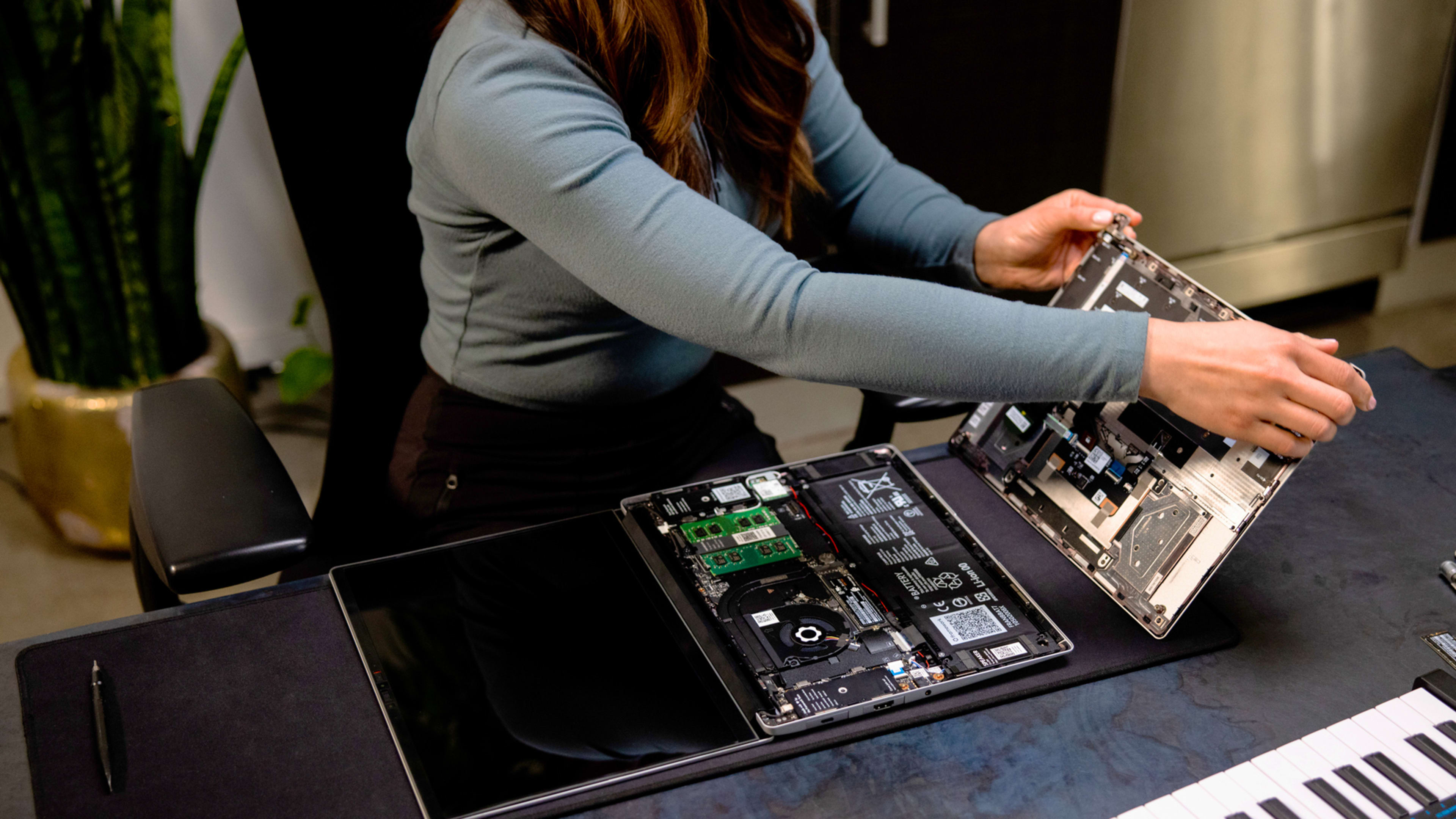A new hardware startup is trying to make a name for itself by selling you fewer new devices.
It’s called Framework, and its first product is a laptop that will let users replace or upgrade every component on their own, from the screen to the keyboard to the mainboard inside. That means customers won’t have to pay a premium for repairs when a part breaks, and won’t have to buy an entirely new laptop just to improve one particular component.
Nirav Patel, Framework’s founder, says that the startup’s ultimate goal is to build an ecosystem of repairs and upgrades around its products so that users can easily breathe new life into their gadgets. In doing so, he hopes to fix what he sees as a broken model for consumer electronics, in which replacing older products often makes more sense than fixing or upgrading them.

Framework’s plan to build an ecosystem around repairable, upgradeable electronics is ambitious, and a lot of companies have failed at similar ideas in the past. But if the startup can convince enough customers and component vendors to get on board, it could offer a much-needed alternative to tech that seems disposable by design.
Making a more resilient laptop
Before founding Framework, Patel was part of the original team at Oculus VR and spearheaded the hardware architecture for nearly all of its devices. Before that, he spent three years as a software engineer at Apple.
Those experiences, he says, attuned him to the disposable nature of consumer electronics. Device makers don’t always design their products around easy repairs, nor do they optimize their supply chains around long-term device upkeep—and trend that’s gotten worse over time as hardware companies have prioritized thinness over ease of repair. As a result, both the price of components and the cost of repairs or upgrades can be more expensive than they ought to be.
Nirav PatelThe industry isn’t going to fix itself.”
Repairing the screen on a MacBook Air, for instance, costs $99 with an AppleCare+ plan, which itself costs $249 for three years of service. Apple doesn’t say how much repairs cost without its extended warranty program, but the price is presumably significantly higher. While Patel won’t say how much a Framework replacement screen might costs, he suggests that it’ll be much cheaper.
“When you crack a MacBook screen, you’re replacing the entire lid assembly, which includes the CNC aluminum housing, the webcam, the front glass, and all of that,” he says. “Whereas with the Framework laptop, if you happen to crack the screen, you’re just replacing the screen.”

Patel says he wants people to keep Framework’s laptop for at least twice as long as they typically would.
“The person who buys a notebook every four years . . . but is kind of suffering through the last two years, we want to give them the ability to have eight happy years out of this product,” he says.
While Framework isn’t yet announcing a price for the laptop, which will launch this summer, Patel says it’ll be on par with other premium laptops that have similar tech specs, such as Dell’s XPS 13 and Microsoft’s Surface Laptop. (Those devices can range from around $1,000 to $2,000, depending on configuration.) The company isn’t revealing component prices either, but Patel says customers will have clear incentives to repair or upgrade their laptops, rather than replace them.

Longevity is the point
Framework isn’t the only laptop maker that’s embracing repairs and upgrades. Kyle Wiens, the cofounder and CEO of iFixit, points out that PC makers like Dell, Lenovo, and HP all make laptops that are easy to repair and sell replacement parts through their websites.
“If you want a serviceable laptop, they’re out there,” Wiens says.
Still, Framework is going a step further by building its brand around the idea of modularity. Being able to replace your computer’s processor is common in desktop computing, but it’s largely unheard of in laptops. Patel says Framework is in talks with major chip makers about selling upgradeable parts, and the company is developing a miniature desktop case that can house the laptop’s current mainboard. If users upgrade to a new laptop processor, they could repurpose the old one as the brains of a lightweight desktop computer.

Meanwhile, Framework’s most clever flourish is a system of interchangeable ports that fit into the laptop’s frame. This allows users to choose whether they want extra USB ports, HDMI outputs, MicroSD card slots, or additional storage, and they can swap out the modules for a different set of connectors whenever they want.
“It’s just taking the dongles that we carry around, and compressing them right into the system,” Patel says.
Ecosystem play
Over time, Patel hopes Framework will become more than just a hardware maker. The broader goal, he says, is to establish its own marketplace where users can buy new parts and sell their old ones. Framework will also offer an open license for its components in hopes that third-party vendors will make their own parts.
Eventually, Framework wants to move beyond the laptop as well. Patel says the startup is considering other product lines with geekier consumer bases that might conceivably appreciate upgradeable parts, such as audio/video gear, gaming, and photography.
If all goes to plan, the result would be a virtuous cycle, in which Framework customers are constantly returning the marketplace to upgrade their gear, offload what they already have, and perhaps learn about new kinds of sustainable products to buy. That broader ecosystem play could be the key difference between Framework and other startups that have built their brands around repairs and upgrades, such as Fairphone and Teracube in the smartphone business.
Nirav PatelA lot of the modules in the product actually have life beyond the product itself.”
“Rather than focusing on one-off products like most consumer electronics are, we think about it in terms of ecosystem,” Patel says. “We think about it in terms of longevity.”
At some point, though, all of this starts to sound like wishful thinking. The consumer electronics industry has a rich history of failed attempts at making products with convenient, modular upgrades, from Google’s Project Ara to Razer’s Project Christine. The big challenge with these kinds of projects is convincing component vendors to get on board, which isn’t easy when there’s no existing user base and the entire concept remains unproven.

But ultimately, Framework will have to convince consumers to take a leap of faith. That means launching with a laptop whose quality can stand on its own, with novel features like the modular port selection and a 1080p 60 frames per second webcam, which itself is a rarity among laptops these days.
In the meantime, Framework isn’t offering any sort of guarantee that its products will be upgradeable for years into the future—it is a startup, after all—but consumers who are intrigued by the idea of an endlessly modular laptop don’t have much alternative.
“For notebooks, we’re going into a space where there’s no option at all for consumers except for buying these locked-down, sealed-up products,” Patel says.
Recognize your brand’s excellence by applying to this year’s Brands That Matter Awards before the early-rate deadline, May 3.
